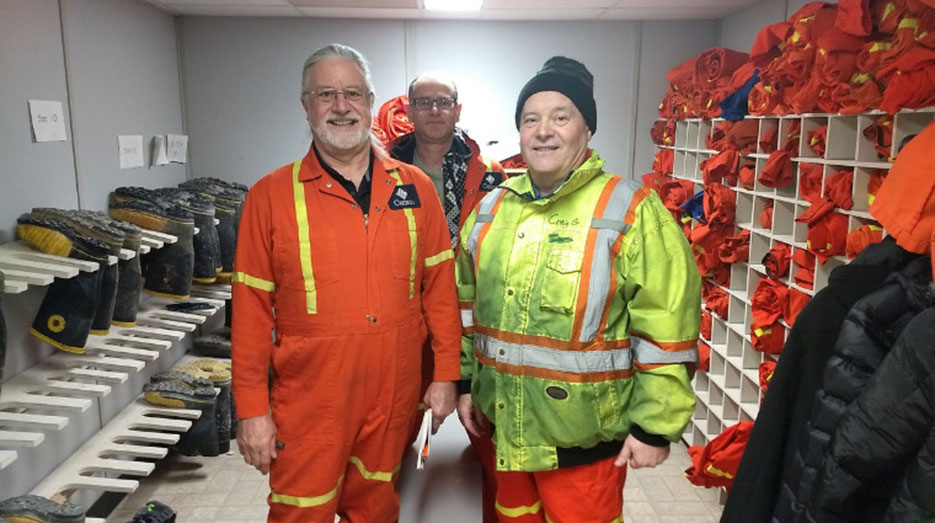
A Polytechnic First
Using artificial intelligence and machine learning to improve mining processes.
The mining industry is increasingly using artificial intelligence (AI) and machine learning as tools to optimize processes, create efficiencies, increase production and enhance decision-making.
Over the past two years Saskatchewan Polytechnic’s Digital Integration Centre of Excellence (DICE), Saskatchewan's first and only Technology Access Centre (TAC), has been working with Cameco on an applied research project that uses artificial intelligence and machine learning to advance their uranium mining processes.
“We are truly innovating in the mining sector. This is the first artificial intelligence and machine learning project completed by a polytechnic for the mining industry,” says Dr. Terry Peckham, Sask Polytech DICE TAC director. “Sask Polytech has the only TAC completing projects in artificial intelligence and machine learning in Canada.”
Mining uranium in Canada's north is challenging, to say the least. To succeed in this difficult environment, Cameco has successfully mechanized their operations using jet boring technology. A team of ten Sask Polytech researchers has been working with Cameco to use artificial intelligence and machine learning to create a model to improve the accuracy of jet boring mechanics to extract uranium. This has been a labour-intensive, time-consuming process that includes collecting, analyzing and synthesizing large amounts of mining data from Cameco in order to form conclusions to improve processes. The DICE team confirms the effectiveness of their data assumptions by working collaboratively with Cameco’s engineers and geologists on recommended areas to test and drill in a production environment. Data from these tests are used to improve outcomes and this reiterative process continuously refines the accuracy of the model to enhance the jet boring recipe.
“After two years of collaboration with Cameco, following a guided sequence of analysis, Sask Polytech’s team has created a prototype artificial intelligence model for Cameco that shows potential to better predict process outcomes for mining uranium with about 90 per cent accuracy,” says Peckham. “We have created and refined a unique cutting recipe to make the jet boring system more precise. This not only improves processes, but also saves valuable time. Using artificial intelligence and machine learning removes the labour-intensive component of the mining planning process.”
“Uranium mining is a highly competitive global industry,” says Jeremy Breker, Cameco’s vice-president of Technical Services. “Every efficiency improvement reduces our production costs and strengthens our ability to compete.
“A common challenge in the mining process is to extract as much of the valuable ore as possible while minimizing the amount of surrounding, unusable material mined. It is costly to separate out that waste.
“The jet boring system can at times be less precise than you’d like in this regard. Our work with Sask Polytech is aimed at fine-tuning this system to make it more predictable and efficient. This will be incredibly valuable to Cameco, saving precious dollars, reducing waste and improving our cost-competitiveness.”
“Cameco has supplied our team of researchers with billions of points of information including sensor data, rock characteristics, geological information and results of the extraction process. We took all of this information and started looking at different relationships in the data. Using this data, Cameco can now better optimize their jet boring recipe to extract valuable uranium,” says Dr. Cyril Coupal, DICE research manager.
“We use Cameco’s data to train the computer how to predict successful mining algorithms,” adds Kelvin Boechler, DICE research manager. “It’s an iterative, interactive, collaborative process with Cameco. We test these algorithm outcomes, validate the results and Cameco is better able to refine their mining models and processes.”
This project combined Cameco’s unique uranium mining knowledge with Sask Polytech’s experience working with artificial intelligence and machine learning. “This is the first uranium mining project using artificial intelligence and machine learning to optimize mining processes,” says Peckham. “It’s an exciting project for our research team and students.”
Several Computer Systems Technology diploma students were hired as student researchers for this project. They were able to put the theory they learned in class into action.
“As a student researcher and data analyst I had the opportunity to explore the most cutting-edge technology on data visualization and machine learning,” says Ying Ye, Computer Systems Technology student. “My main task was to organize raw data from Cameco, check data integrity and update the database. I also assisted with data visualization and math calculations so the machine learning could have deep insight into our dataset. I learned how to apply computer science within the mining industry.”
“This is a complex Saskatchewan problem being solved by Saskatchewan people. Working with Cameco we have been able to sharpen our artificial intelligence and machine learning skills and validate our expertise,” says Peckham. “This has been an amazing project for our researchers and students, with great results for Cameco. We will continue building on our artificial intelligence expertise with projects in mining, agriculture and cybersecurity.”
DICE operates under Sask Polytech’s Office of Applied Research and Innovation and is staffed with highly qualified specialists and technologists experienced in providing digital solutions focused on data. Business and industry partners who work with DICE, retain all intellectual property arising from their applied research projects. Cameco owns the intellectual property and exclusive artificial intelligence model created for them throughout this applied research project.
This project was funded by Cameco, Natural Sciences and Engineering Research Council of Canada (NSERC), Mitacs and International Minerals Innovation Institute (IMII).
DICE provides innovative solutions for solving data and digital challenges for business, industry and non-profits. By partnering with DICE, organizations have access to outstanding computational facilities, faculty expertise, and talented student researchers, along with research and development funding and a vast network of connections. The DICE team of specialists and technologists are all experienced in providing digital solutions focused on data across a spectrum of industries.
To learn more visit saskpolytech.ca/dice.
April 2022